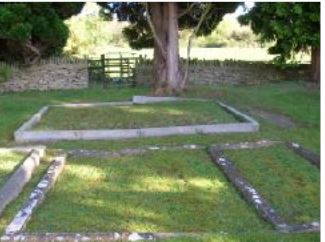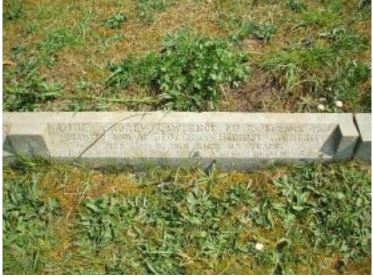Norfolk Regiment

Alfred Andrew Lawrence was a soldier who never served outside of the UK and who was a victim of the 1917-19 ‘Spanish Flu’ pandemic.
He was born at Wyck Rissington, near to Bourton-on-the-Water in 1885: his parents were George Lawrence (1834-1893), an agricultural labourer and his wife Harriet (née Framiloe: 1848-1936). The couple had six children, of whom five had survived by the time of the 1911 Census).
The family were long time residents of Wyck Rissington and the 1901 Census shows Alfred, aged 15, as a ‘garden boy, domestic’. Ten years on, the 1911 Census shows Alfred as the only child living with his mother, who was, the census notes ‘supported by her son’. Alfred was a domestic gardener.
An Army Service Record has survived for Alfred, which is quite detailed. He attested for military service, for the duration of the war, on 26 November 1915. This was almost certainly under ‘Lord Derby’s Scheme’, which was introduced to facilitate voluntary enlistment, prior to the introduction of compulsory conscription, imposed in the following March. His attestation form shows him to be 30 years and one month and a ‘gardener and organist’
He was posted to the Army Reserve and awaited mobilisation, which did not come until 25 September 1916. Initially he was posted to the 5th Battalion, Norfolk Regiment (with the number 7227) but almost immediately was switched to the 1/6th Battalion, who remained in the UK for the duration of the war, principally on coastal defence duties in Norfolk. There is mention in his papers of Alfred being categorised as B2, for fitness purposes, which rendered him fit for most duties, outside of frontline service.
On 4 January 1918 he was transferred to 6th Training Battalion, Royal Army Medical Corps at Blackpool and his number changed to 135698). He was not with them long as, for whatever reason, on 23 February 1918 he joined 494 Agricultural Company, Labour Corps at York and was given the number 528883.
Agricultural Companies in the Labour Corps served to assist local farmers with food production and bringing in the harvest etc, replacing the usual workers who had been conscripted into the Army.
In November 1918 Alfred was working for W E Cox Ltd, a fruit and potato producer at Manor Farm, Bawtry Road, Bessacar, near Doncaster, when he fell ill with the ‘Spanish Flu’, which was then sweeping the country, as part of a world wide pandemic. He died there on 8 November, aged 33. His service file contains a letter written by his employer, Mr Cox, confirming that he ‘died from epidemic of flu’ and that his mother had travelled to be with him and requested (of the authorities) that a warrant be issued to enable his body to be brought home by rail to Stow-on- the-Wold. His Army career had lasted just short of three years.
Alfred’s body was returned to Wyck Rissington (St Lawrence) Churchyard for burial on 13 November 1918. He doesn’t have a CWGC headstone, rather his grave is marked by a rectangular stone kern, on which his name and details are inscribed. It is likely that, due to weathering, some form of CWGC marker will be put there, to ensure perpetual commemoration. He is commemorated on the Great War Memorial plaque inside St Lawrence Church.
The Cheltenham Chronicle of 24 April 1920 carried a report that his sister ‘gave a brass memorial to the church, where for sometime he had been the organist’. Stow Deanery Magazine said ‘we are glad to have such a memorial of one so who was so respected and loved by all who know him in Wyck Rissington’.

Researched by Graham Adams 13 April 2021
